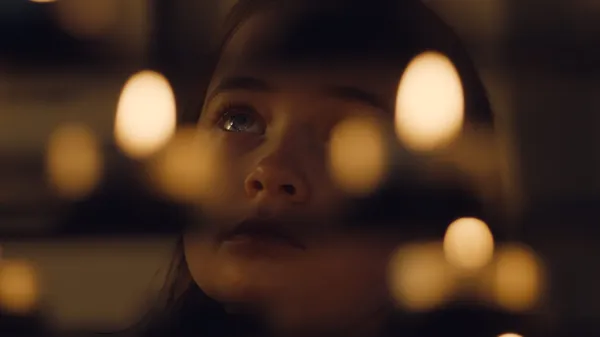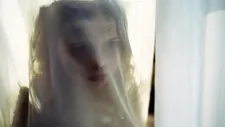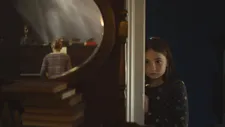 |
| Martyrs Lane Photo: Fantasia International Film Festival |
A haunting little fable about a lonely girl and her mysterious nightly visitor, Martyrs Lane is one of the highlights of this year’s Fantasia International Film Festival. It’s the third feature-length work directed by Ruth Platt, adapted from her 2019 short, and it hinges on a beautifully balanced pair of performances by child actors Kiera Thompson and Sienna Sayer. Early on in the festival we met up to discuss it. She explained that she had always wanted to make it as a feature, with the short serving as a proof of concept, and I asked her how she went about finding the right children to make it possible.
Being on a limited budget had a big impact on the casting process, she says. She couldn’t be like Michael Haneke, seeing 5,000 children to find the right ones for The White Ribbon, or like the makers of Norwegian film The Innocents, who spent years on casting.
“We were limited in how many kids we could see. I guess it was about 300 to 500 kids. And a very important thing for me was how natural they were, and also their chemistry together, these two kids, because I didn't want to manufacture them too much, or, like, impose too much on them. I want them to be something for themselves.
“And then these two kids came in. And it was a while before we put them together. But as soon as we did, I realised that chemistry they have. That’s so interesting and that's something you can't really fake. And yeah, I don't think one of them would work without the other. It's weird. I don't think you know, I could have cast one of them with someone else, we kind of tried that, and it just felt completely off. We just knew they had to be together. So that was really lucky. That works. But it was quite a long process of casting and putting pairs together, and trying different like games and rotations and trying to see them, you know, because they they want to put on a performance and then they realise, okay, we don't need to do that. And then they start to relax. And that was probably quite a long process.”
I ask about the process of working with the children. How much did they understand the nuance of the story, and how much were they able to improvise and run with that?
“They were both really, really great kids,” she says. “They just weren't fazed by anything. I think children's imaginations are pretty much the same as anyone’s. There’s this thing about appropriate things and things you need to protect them from, but I guess we talked very much in the moment of the scene, and they just clicked. It was it was play to them. But also, you know, once they realised it was about being truthful to that moment and what you're thinking in that moment, and how you're interacting with the other person, they realised that that's what it's about. And just that getting that playfulness and that sense of increasing frenemy kind of energy going on. They just get it. So it was about just keeping them in the moment, keeping them very present. That was what I tried to focus on, rather than giving them the whole arc of the story.”
 |
| Careful who you invite inside |
So was it scripted? Or were they improvising around what she needed them to do?
“I worry it's too scripted,” she says, pleased that that wasn’t obvious to me. “I'd love to give them more space to be more improvisational. I tried a little bit to create improvisation but a lot of it was quite scripted. I was a bit worried that, you know, as soon as you do that you're kind of giving an adult's lens to what they're doing, but we tried to free up that dialogue and give them a little bit space to move with it. So I'd love to have done that more.”
I tell her that I like the way the film respects that children can have dark imaginations and gives its young heroine, Leah, agency rather than treating her like a helpless innocent.
“Yeah, exactly,” she says. “And there's a great tradition, I think, of those kind of films. I watched a lot of films from the child's point of view where children are overhearing and sort of filtering adult secrets or suppressed stuff, through the things that adults are trying to get away from them. Because children do overhear and do make sense of stuff, even if they make sense stuff through their own imagination, piecing together stuff. And they have real agency, like you say. They're not just like innocent, passive kind of characters. And so, yeah, there are a lot of films like Night Of The Hunter and you know, Guillermo Del Toro films and Spirit Of The Beehive, where children really have real agency and you are bound to the perception, and it hopefully reminds you of your own childhood, in a way.”
She also gets interesting performances from her adult cast, especially Denise Gough as the mother and Hannah Rae as the older sister, both of whom have their own complex issues going on and things that they're trying to hide. How did she approach that as a writer and as a director, to let us know that something’s going on without giving too much away?
“It’s interesting because all actors have different processes,” she says. “I trained as an actor and so I hope I have a kind of shorthand, but I think some actors are quite protective of their own process, and then you have to step back and let them let them be instinctive in that way, and not talk it through too much. And then other actors want to talk it through a little bit more, that backstory and what they're bringing to that performance, and what’s there from your point of view as well, and try and make that more collaborative. So it's quite a kid gloves process, I guess, especially with something that's got quite difficult emotions and, and trauma and memories and things like that, you've got to be very careful. But yeah, I mean, with Denise, I think she likes to work in a very instinctive way. And I was quite hands off with her really. And then with Hannah, again, she's fantastic. And it was really great to talk through the backstory, but she, again, had this lovely chemistry with Kiera. So I guess you try and bring as much as you can from the place with that authenticity and hope that that translates onto the screen.”
The film has elements of folk horror and there are a lot of films like that, where there's a tension between Pagan elements and Christian elements leading to hostility Here, though, both are present but there’s also a couple who are happy living together despite that difference in how they see the world. Was it interesting for her to explore how those things can sit side by side without necessarily being being at odds?
“Yeah, I mean, because I guess, there's so much Paganism in Christianity. All the festivals come from the Pagan festivals and, you know, there's these beautiful carols like The Holly And The Ivy, which are all about those Pagan rituals, you know, the natural world. And that was very much part of my childhood. So I think that that is something that felt very natural to me, because it's kind of what I grew up with.
“And the other issue of the father and mother, how they make the relationship work, is not an autobiographical story, but there's a little bit of biographical truth in that. My parents sacrificed their personal lives for this kind of very practical ministry, very passionate about social justice. It was very outward facing. They didn't want to do loads of praying and internal kind of musing. It was very much about trying to be of practical help. And I think, because of that outward facing kind of ministry, they didn't always look very closely, or they felt it was a bit indulgent, to focus on their own emotions and stuff. Which can work, but it can also create stuff that doesn't get solved. And so I was interested in looking at that dynamic.”
There's also tension in the film around the fact that the older daughter is going away to study, and obviously both parents have emotions going on around that, but it isn't addressed directly.
“I guess it’s about what isn't said and what Leah does is she's always picking up on what isn't said, or other clues. And what might she have missed? It's all about subtext, and then she filters it through in a very direct, very head on way. And that's what we see, all the stuff that she picks up from what the adults don't quite say.”
There are elements of ghost story in there which blend beautifully with different elements from Pagan tradition.
“There's a lot of Spanish ghost stories in cinema, they've been very influential,” she says. “And then I guess, yeah, the British Pagan tradition, those folk horror films are quite influential. And all those little totems or little things she finds, that she keeps on her altar. It's almost like she's a little priestess herself, you know, gathering all these sorts of things that mean something to her and are very sacred. There are stories in the British tradition that have influenced me in that. The Gothic tradition has influenced me a lot as well, you know, like Wuthering Heights and Frankenstein, and then the ghost stories of writers like MR James, Wilkie Collins, all those things filtered through as well. But the natural world and the organic world probably does come from that sort of Pagan tradition, folklore tradition. And I think it's a process of just assimilating my own childhood with the things I've watched and perceived and experienced. It's been quite an organic process.”
It’s an approach to storytelling made easier by a fantastic location.
“We were really lucky with that location because we had to shoot in London because of the budget,” she explains. “And it's really hard to find a big old rambling vicarage these days. And it was funny, because we got tipped off about this house, which is right next to Harrow School, which is, you know, very posh, on this hill. It doesn't look like London at all. It's just this kind of little village on top of the hill, but they had this old vicarage that wasn't being lived in because the school had bought it but they hadn't managed to renovate it yet. Because all the old vicarages get bought off and then divided up, which is fair enough, because they’re all massive and all falling apart. So we that house was actually empty. And that's why we were lucky enough to film that. I don't know if they've actually moved on to building it up yet. But to find a big old house like that within the M25, empty - and you've got to get that sense of decay slightly, you know, things falling apart - we were very, very lucky to find that.”
 |
| Eavesdropping |
Did they have to move around elsewhere to find other outdoor locations, or were those close to the house?
“Again, just due to budget, we had to keep everything really tight. Children's hours are so short and tight. It was a very long shoot, but the hours each day were quite limited. There's quite a lot of dark, you know, night shoots and stuff. So we just had to keep everything very small, very local. So we just had to do a lot of finding places around the area.”
There’s tremendous art design there in the house, with really detailed sets. It's very convincing as a space that a child would create in her room. What went into that process? How involved was she?
“I was quite involved,” she says. “We had a brilliant production designer, Gini Godwin, and a brilliant art department as well. May Davies was fantastic. I talked a lot to them about all the little details of the house. I guess we were looking for quite a retro aesthetic – slightly timeless, but also slightly retro. There's also foreign movies from the Seventies and Eighties.
“I imagined Leah almost like a little ghost, so she wore very dark clothes and was very dark. So she was sort of camouflaged, just like invisible in this big old house. We got a lot of stuff from, again, my childhood, I was always rescuing stuffed toys and broken dolls from jumble sales and trying to mend them. And that kind of came from a childhood memory of like, toys that are slightly broken down or old and like a sanctuary for broken souls, which obviously has that horror kind of aesthetic.”
There’s a rabbit too – children and animals on one in one film.
She laughs. “Yeah, yeah, it's fantastic. A big, big rabbit with big red eyes. Quite a horror look. We had the rabbit and we had the dog, and children.”
Overall, it’s not the kind of film we see very much these days. To me it’s a treasure, but did that make it difficult to identify a market?
“I think everyone was a bit worried about that because it's a ghost story and it's not like a slasher film or found footage, and it's not uber stylized. It's about trauma and grief and emotions, I worried about quite where the market would be. We all wanted to make it and it was something that we worked so hard to make that we just thought, well, we'll put it out there. But I do worry slightly. what people will think of it, whether it's going to communicate to people.”
With this in mind, getting picked up by Fantasia came as a relief.
“Oh, yeah, that was wonderful. You know, I love Fantasia. And Mitch has spoken very passionately about the film, which is just so lovely. We made the film in late 2019 and then we were just starting to edit it when Covid came along and delayed it for a really long time. My editor was working from home, and I wasn't really in the edit. And so I was picking up the phone and talking to him, which is quite difficult, to be removed from it completely. I think I had three days in the end, just to go through stuff. So it was all remote. And a lot of the post production was remote as well.
“So I was just thinking, where do we go from here? I’m not sure what the horizon’s looking like for cinema. And so when Fantasia picked it up, it was it was a massive relief, really exciting. I just think it's such a perfect festival for us. It's got that balance of sort of, you know, the supernatural, but also the slightly offbeat kind of magical realism as well. And so yeah, I'm really excited.”
It may require word of mouth for Martyrs Lane to find its natural audience, but it’s a film that fans of more thoughtful, emotional genre fare would be fools to miss. It screens at Fantasia on 19 and 21 August.





















